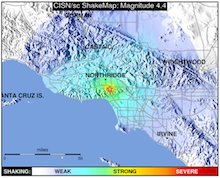Ken Schwencke’s early story about the earthquake that affected Los Angeles Monday morning bears an unusual note:
This information comes from the USGS Earthquake Notification Service and this post was created by an algorithm written by the author.
Reached by phone, Schwencke said he began working on the algorithm, which he calls Quakebot, after the 2011 earthquake in Japan. “Living in a seismically active place ourselves, I started playing with using the USGS data feeds,” he said. The U.S. Geological Survey has a “wonderful data notification service which sends out emails,” Schwenke said.
Schwencke is a digital editor on the Times’ data desk, where he is a reporter and a programmer. Using parameters he set, Quakebot will write a story based on details from seismic events with a “newsworthy magnitude,” put a post into the Times’ CMS, generate an image based off Bing maps and tell copy editors the story is ready. Quakebot also shares info from USGS about revisions to the event — if the agency downgrades a quake’s magnitude, as happened today, or if sensors in California mistakenly pick up a quake elsewhere.
The speedy process means the Times can get its quake stories out quickly, which “provides a baseline starting point,” Schwencke said. “A bunch of editors and reporters went in and added context” after the initial hit.
Schwencke also built Homicide Report, which Sara Morrison wrote about for Poynter last month. An algorithm for that site turns every murder report into a basic story that reporters can dig deeper into.







Comments